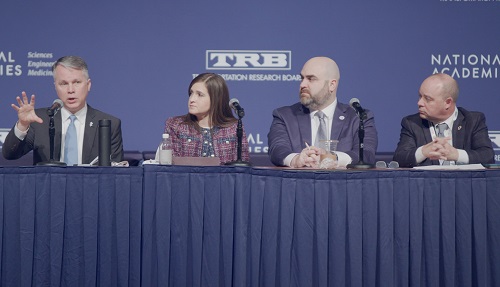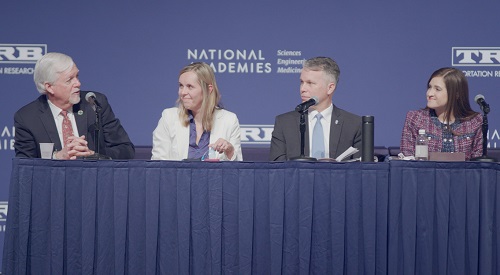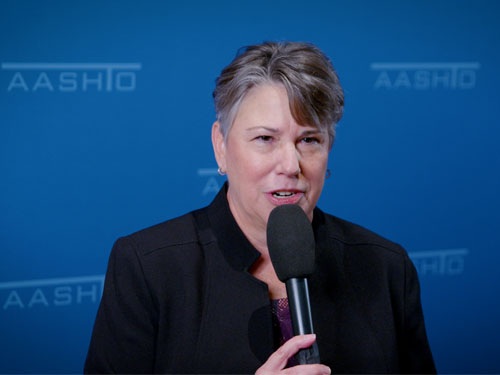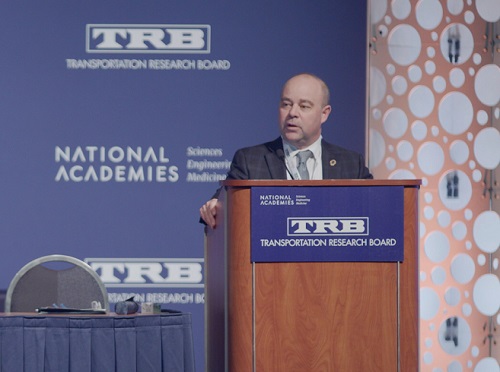Craig Thompson (above), secretary of the Wisconsin Department of Transportation and 2023-2024 president of the American Association of State Highway and Transportation Officials, outlined key transportation challenges faced by states and the nation as a whole during a session at the 2024 Transportation Research Board Annual Meeting in Washington, D.C.
[Above photo by AASHTO]
During a panel discussion, Thompson illustrated how his AASHTO presidential emphasis areas – themed “Transportation Together” – could help “make the most out of the extremely exciting and transformational time right now” in the transportation sector.
“I’m looking at how the capabilities of AASHTO as an organization, and the combined resources and expertise of its members, can be best brought to bear and enable us to work effectively together,” he said. “With historic investment in infrastructure across the nation, innovation reaching every corner of the industry, and technology evolving in unprecedented ways, we are paving the way for the future of mobility.”

Garrett Eucalitto, commissioner of the Connecticut Department of Transportation and 2023-2024 AASHTO vice president, emphasized that Thompson’s emphasis areas are a direct reflection of the major challenges facing the state DOT community now and in the near future.
“I think they are really reflective of what many of us who are leading state DOTs talk to our teams about every single day,” he said. “Focusing on delivering on the federal infrastructure investments, and doing it together, that’s something that requires focus and patience. Progress requires patience, especially on the infrastructure.”
Turning to the workforce side, Eucalitto said all state DOTs are having the same problems trying to find candidates to fill available jobs all throughout their organizations – not just on the engineering side.
“Half of our agency is made-up of our maintainers who go out every single day and maintain the roadways, plow the snow, etc.,” he said. “They make the infrastructure safe for people to [use] and we’re seeing significant shortages of maintainers now, so we’re trying to come up with innovative solutions to get more people into those positions.”

Nicole Majeski, secretary of the Delaware Department of Transportation and chair of the AASHTO Council on Public Transportation, touched on safety and how state DOTs continually reinforce that safety is and will remain their top priority.
“It is the most important thing we do, and we in Delaware – like every other state – watched our [roadway] fatality numbers skyrocket over the last few years,” she said. “In fact, 2022 was the deadliest year that we have had in our state.”
As a result, Majeski noted that Delaware DOT made a decision to be “very intentional” talking about roadway deaths and injuries as a way to reinforce why safety is a top priority.
“So for the last two years, every single presentation that I have done – regardless of the audience – I start by saying, here’s how many people have died on our roads this year. Here’s how many people have died this week,” she said. “It’s not fun talking about death every single day but I’m very intentional about it because to it is the only way to get people’s and our legislature’s attention.”
Roger Millar, secretary of the Washington State Department of Transportation and immediate past AASHTO president, emphasized Majeski’s points by painting a broader picture of the safety issue in terms of funding allocated to address it.
“The combined annual budgets of state DOTs total about $200 billion – that is what is spent on our surface transportation work in America,” he said. “But the societal cost of crashes in the United States is $1.4 trillion. It is seven times the combined budgets of all of the state DOTs. So what we really need to do is ramp it up and go big in the transportation space in regards to safety. Because that will be an investment that pays a return on investment in lives and dollars saved in the safety space.”
Eileen Vélez-Vega – secretary of the Puerto Rico’s Department of Transportation and Public Works or “DTOP” and chair of the AASHTO Council on Aviation – noted during the panel discussion that the prioritization of safety is also partly rooted in how state DOTs are addressing changing demographics when it comes to mapping out mobility needs of the future.
“In Puerto Rico, the population is about 33 percent elderly and it’s rising, so we have to also think about how are we going to serve that population and how we going to improve mobility for them,” she said.
“And so we’re using different strategies at the department to change the concept of transportation and mobility,” Vélez-Vega noted. “It is about changing the language and the perception of not moving from one place to another, but about what is that quality of that trip and also what other mobility options are available. That is very important for us in Puerto Rico because it’s a shift on [transportation] priorities and requires a different way of thinking.”
Patrick McKenna – director of the Missouri Department of Transportation, chair of the AASHTO Committee on Safety, and a former AASHTO president – noted that his state is also engaged in a “different way of thinking” that was developed in response to the $1.2 trillion Infrastructure Investment and Jobs Act.
“We were planning for a federal bill before it happened, [focused] on really drawing in our local communities,” he said. “So we go through a capital planning process every year; every state DOT does it. But ours really became a ‘bottom-to-top’ approach, meaning the vision for transportation improvements across our state comes from its local communities.”
So, in addition to the state’s transportation capital planning process, McKenna said Missouri DOT put together an “unfunded needs” capital project list – one developed by touring the entire state, going into each of regions, and asking communities what they needed.
“It was about developing priorities and how they would direct the state DOT to work on those priorities,” he noted. “That has really expanded our the local communities because now we have a joint ‘vision process’ so we have a list of community based projects ready to start working on if we get the funding.”
 Top Stories
Top Stories
USDOT Makes $1.5B Worth of BUILD Grants Available
December 19, 2025 Top Stories
Top Stories

